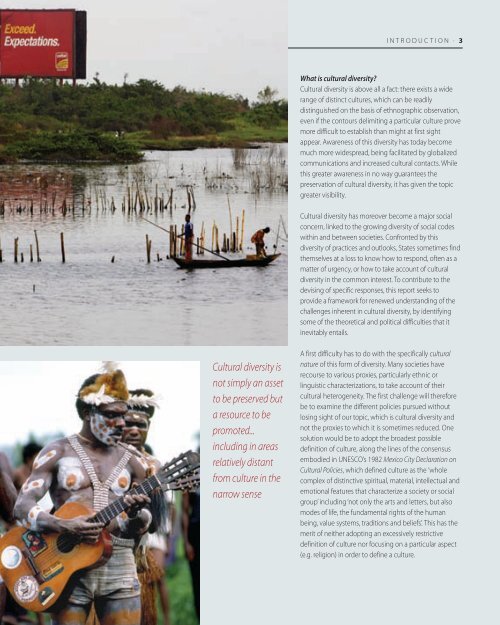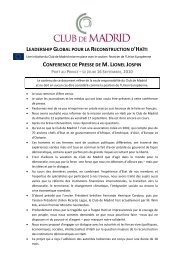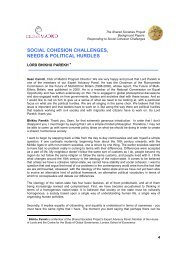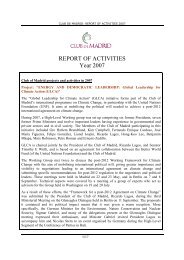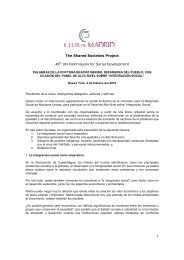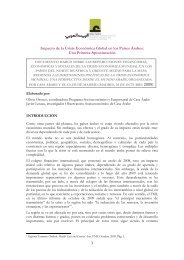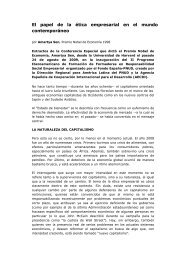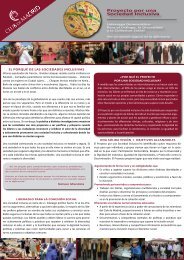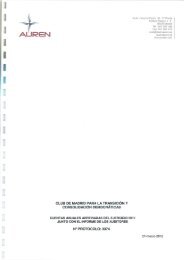Investing cultural diversity and intercultural dialogue - Business and ...
Investing cultural diversity and intercultural dialogue - Business and ...
Investing cultural diversity and intercultural dialogue - Business and ...
You also want an ePaper? Increase the reach of your titles
YUMPU automatically turns print PDFs into web optimized ePapers that Google loves.
INTRODUCTION . 3<br />
What is <strong>cultural</strong> <strong>diversity</strong>?<br />
Cultural <strong>diversity</strong> is above all a fact: there exists a wide<br />
range of distinct cultures, which can be readily<br />
distinguished on the basis of ethnographic observation,<br />
even if the contours delimiting a particular culture prove<br />
more difficult to establish than might at first sight<br />
appear. Awareness of this <strong>diversity</strong> has today become<br />
much more widespread, being facilitated by globalized<br />
communications <strong>and</strong> increased <strong>cultural</strong> contacts. While<br />
this greater awareness in no way guarantees the<br />
preservation of <strong>cultural</strong> <strong>diversity</strong>, it has given the topic<br />
greater visibility.<br />
Cultural <strong>diversity</strong> has moreover become a major social<br />
concern, linked to the growing <strong>diversity</strong> of social codes<br />
within <strong>and</strong> between societies. Confronted by this<br />
<strong>diversity</strong> of practices <strong>and</strong> outlooks, States sometimes find<br />
themselves at a loss to know how to respond, often as a<br />
matter of urgency, or how to take account of <strong>cultural</strong><br />
<strong>diversity</strong> in the common interest. To contribute to the<br />
devising of specific responses, this report seeks to<br />
provide a framework for renewed underst<strong>and</strong>ing of the<br />
challenges inherent in <strong>cultural</strong> <strong>diversity</strong>, by identifying<br />
some of the theoretical <strong>and</strong> political difficulties that it<br />
inevitably entails.<br />
Cultural <strong>diversity</strong> is<br />
not simply an asset<br />
to be preserved but<br />
a resource to be<br />
promoted...<br />
including in areas<br />
relatively distant<br />
from culture in the<br />
narrow sense<br />
A first difficulty has to do with the specifically <strong>cultural</strong><br />
nature of this form of <strong>diversity</strong>. Many societies have<br />
recourse to various proxies, particularly ethnic or<br />
linguistic characterizations, to take account of their<br />
<strong>cultural</strong> heterogeneity. The first challenge will therefore<br />
be to examine the different policies pursued without<br />
losing sight of our topic, which is <strong>cultural</strong> <strong>diversity</strong> <strong>and</strong><br />
not the proxies to which it is sometimes reduced. One<br />
solution would be to adopt the broadest possible<br />
definition of culture, along the lines of the consensus<br />
embodied in UNESCO’s 1982 Mexico City Declaration on<br />
Cultural Policies, which defined culture as the ‘whole<br />
complex of distinctive spiritual, material, intellectual <strong>and</strong><br />
emotional features that characterize a society or social<br />
group’ including ‘not only the arts <strong>and</strong> letters, but also<br />
modes of life, the fundamental rights of the human<br />
being, value systems, traditions <strong>and</strong> beliefs’. This has the<br />
merit of neither adopting an excessively restrictive<br />
definition of culture nor focusing on a particular aspect<br />
(e.g. religion) in order to define a culture.


